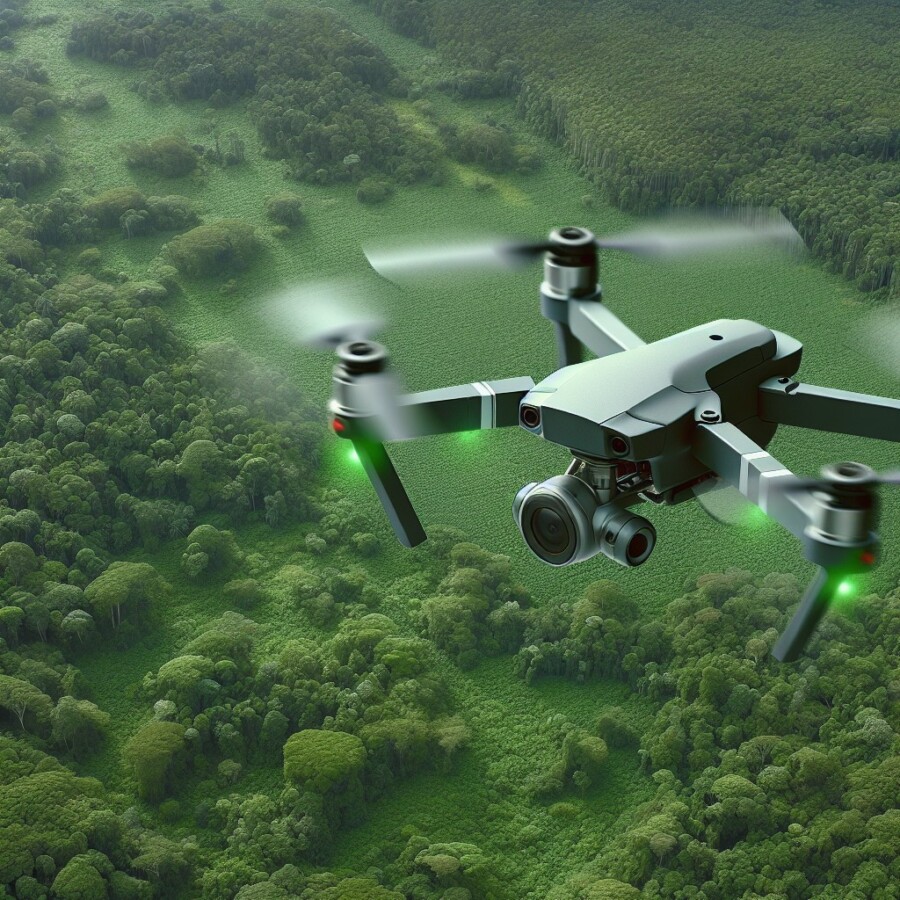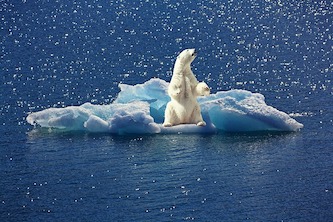A missing dog in Bedfordshire, England, was successfully found and reunited with its family after 12 days, thanks to the use of a thermal camera attached to a drone. The dog, named Ulysse, was located hiding in a hedge, and the rescue operation was carried out by the charity Drone to Home. The thermal camera captured Ulysse as a bright white blob in the video footage. The owner, Sam Boyle, is now raising funds for the charity to purchase another drone to assist in finding more lost animals.
The heartwarming story of Ulysse’s rescue highlights the effectiveness of using advanced technology, such as thermal drones, in locating missing pets. The thermal camera was able to detect Ulysse’s body heat, making it easier to spot him even in dense vegetation. This innovative approach to search and rescue operations has proven to be successful in reuniting lost animals with their families.
The use of drones equipped with thermal cameras has become increasingly popular in recent years, not only for finding missing pets but also for various other applications. These include search and rescue missions, monitoring wildlife, and even assisting in firefighting operations. The ability of thermal cameras to detect heat signatures makes them invaluable tools in situations where visibility may be limited or when searching for individuals or animals in challenging environments.
The success of Ulysse’s rescue serves as a reminder of the importance of supporting charities and organizations that utilize advanced technology for the benefit of both humans and animals. By contributing to these causes, we can help ensure that more lost pets are found and reunited with their families. The use of thermal drones in search and rescue operations continues to be a promising and effective method, providing hope and relief to those who have lost their beloved pets.
Original news source: Missing dog found using thermal drone in Bedfordshire (BBC)
🎧 Listen:
Slow
Normal
Fast
📖 Vocabulary:
| 1 | Bedfordshire | A county located in England |
| 2 | thermal | Related to heat |
| 3 | reunited | Brought back together after being separated |
| 4 | hedge | A row of bushes or small trees planted closely together |
| 5 | charity | An organization set up to provide help and raise money for those in need |
| 6 | footage | A sequence of moving images recorded or stored on film or video |
| 7 | innovative | Featuring new methods; advanced and original |
| 8 | detect | To discover or identify the presence of something |
| 9 | vegetation | Plants in general, especially the plants that cover a particular area |
| 10 | applications | Uses or purposes that something can be put to |
| 11 | signatures | Distinctive patterns used to recognize or identify different things |
| 12 | invaluable | Extremely useful or helpful |
| 13 | visibility | The state of being able to see or be seen |
| 14 | challenging | Difficult to do or deal with |
| 15 | relief | A feeling of comfort or consolation in a time of distress |
Group or Classroom Activities
Warm-up Activities:
– Charades
Instructions: Divide the class into two teams. Each team will take turns acting out a word or phrase related to the article using only gestures and body movements. The other team must guess the word or phrase within a time limit. The team with the most correct guesses wins.
– News Summary
Instructions: In pairs, students will take turns summarizing the key points of the article to their partner. After each summary, the partner will provide feedback and ask follow-up questions. Then, they will switch roles. Encourage students to use their own words and express their opinions about the story.
– Vocabulary Pictionary
Instructions: Divide the class into small groups. Each group will be given a list of vocabulary words from the article. One student from each group will come to the front and draw a picture to represent one of the words. The other group members must guess the word based on the drawing. The first group to correctly guess all the words wins.
– Pros and Cons
Instructions: Divide the class into two groups. One group will brainstorm the pros (advantages) of using thermal drones to find missing pets, while the other group will brainstorm the cons (disadvantages). After a given time, each group will present their ideas to the class. Encourage students to provide reasons and examples to support their arguments.
– Future Predictions
Instructions: In pairs, students will discuss and make predictions about the future of using advanced technology, such as thermal drones, in search and rescue operations. They should consider the potential benefits, challenges, and ethical implications. After the discussion, each pair will share their predictions with the class and engage in a group discussion about the topic.
🤔 Comprehension Questions:
1. How was the missing dog, Ulysse, located after 12 days?
2. What technology was used to find Ulysse?
3. How did the thermal camera help in locating Ulysse?
4. What is the charity called that carried out the rescue operation?
5. What did the thermal camera capture Ulysse as in the video footage?
6. What is the owner of Ulysse, Sam Boyle, doing to support the charity?
7. Besides finding missing pets, what are some other applications of drones equipped with thermal cameras?
8. What does the success of Ulysse’s rescue highlight about the use of advanced technology in search and rescue operations?
Go to answers ⇩
🎧✍️ Listen and Fill in the Gaps:
A missing dog in Bedfordshire, (1)______, was successfully (2)______ and reunited with its family after 12 days, thanks to the use of a thermal camera (3)______ to a drone. The dog, named Ulysse, was (4)______ hiding in a hedge, and the rescue operation was carried out by the charity Drone to Home. The thermal camera captured Ulysse as a bright white blob in the video footage. The owner, Sam Boyle, is now raising funds for the charity to purchase another drone to assist in finding more lost animals.
The heartwarming story of Ulysse’s rescue highlights the effectiveness of using advanced technology, such as thermal (5)______, in locating (6)______ pets. The thermal camera was able to detect Ulysse’s body heat, making it easier to spot him even in dense vegetation. This innovative approach to (7)______ and rescue operations has proven to be successful in (8)______ lost animals with their families.
The use of drones equipped with thermal cameras has become increasingly popular in recent years, not only for finding missing pets but also for various (9)______ applications. These include search and rescue missions, monitoring wildlife, and even assisting in firefighting operations. The ability of thermal cameras to detect heat signatures makes them invaluable tools in situations where visibility may be limited or when (10)______ for (11)______ or (12)______ in challenging environments.
The success of Ulysse’s rescue serves as a reminder of the (13)______ of (14)______ charities and organizations that utilize advanced technology for the benefit of both humans and animals. By (15)______ to these causes, we can help ensure that more lost pets are found and reunited with their families. The use of thermal drones in search and rescue operations continues to be a promising and effective (16)______, providing hope and relief to those who have lost their beloved pets.
Go to answers ⇩
💬 Discussion Questions:
Students can ask a partner these questions, or discuss them as a group.
1. What do you think about using drones with thermal cameras to find missing pets?
2. Have you ever lost a pet? How did you feel during that time?
3. How do you think the use of thermal drones can benefit search and rescue missions?
4. Do you think using advanced technology like thermal drones is worth the cost? Why or why not?
5. Have you ever donated to a charity or organization that uses advanced technology for a good cause? If so, which one and why?
6. How would you feel if you lost your pet and someone used a thermal drone to find them?
7. Do you think using thermal drones to find missing pets is a more effective method than traditional search methods? Why or why not?
8. What other applications do you think thermal drones could be used for, besides finding missing pets?
9. Have you ever used a drone before? If so, what was your experience like?
10. What do you think are the advantages and disadvantages of using thermal drones in search and rescue operations?
11. How important do you think it is to support charities and organizations that use advanced technology for the benefit of humans and animals?
12. Do you like the idea of using drones for search and rescue missions? Why or why not?
13. What would you do if you found a lost pet? Would you try to find its owner or keep it for yourself? Why?
14. How do you think the use of thermal drones could impact the future of search and rescue operations?
15. Do you think using advanced technology like thermal drones takes away from the human element of search and rescue missions? Why or why not?
Individual Activities
📖💭 Vocabulary Meanings:
Match each word to its meaning.
Words:
1. Bedfordshire
2. thermal
3. reunited
4. hedge
5. charity
6. footage
7. innovative
8. detect
9. vegetation
10. applications
11. signatures
12. invaluable
13. visibility
14. challenging
15. relief
Meanings:
(A) Difficult to do or deal with
(B) Related to heat
(C) Distinctive patterns used to recognize or identify different things
(D) To discover or identify the presence of something
(E) The state of being able to see or be seen
(F) A row of bushes or small trees planted closely together
(G) A sequence of moving images recorded or stored on film or video
(H) Plants in general, especially the plants that cover a particular area
(I) A county located in England
(J) An organization set up to provide help and raise money for those in need
(K) A feeling of comfort or consolation in a time of distress
(L) Extremely useful or helpful
(M) Featuring new methods; advanced and original
(N) Uses or purposes that something can be put to
(O) Brought back together after being separated
Go to answers ⇩
🔡 Multiple Choice Questions:
1. How was Ulysse located after being missing for 12 days?
(a) A search and rescue team
(b) A thermal camera attached to a drone
(c) A tracking device on his collar
(d) A tip from a neighbor
2. What did the thermal camera capture Ulysse as in the video footage?
(a) A dark shadow
(b) A flashing light
(c) A bright white blob
(d) A moving figure
3. What is the purpose of using thermal drones equipped with cameras?
(a) To monitor weather patterns
(b) To capture aerial photographs
(c) To deliver packages
(d) To locate missing pets and individuals
4. What other applications can thermal drones with cameras be used for?
(a) Filming movies and documentaries
(b) Delivering food and supplies
(c) Search and rescue missions, monitoring wildlife, and firefighting operations
(d) Monitoring traffic and enforcing speed limits
5. Why are thermal cameras valuable tools in search and rescue operations?
(a) They can detect heat signatures in challenging environments
(b) They can track movement from long distances
(c) They can capture high-resolution images
(d) They can communicate with search and rescue teams
6. What is the owner of Ulysse doing to support the charity Drone to Home?
(a) Volunteering as a drone operator
(b) Raising funds to purchase another drone
(c) Donating his own thermal camera
(d) Adopting another lost pet
7. What does the success of Ulysse’s rescue remind us of?
(a) The need for stricter pet ownership laws
(b) The effectiveness of traditional search and rescue methods
(c) The dangers of dense vegetation for pets
(d) The importance of supporting charities that use advanced technology
8. What does the article suggest about the future of using thermal drones in search and rescue operations?
(a) It is a promising and effective method
(b) It is too expensive to be practical
(c) It is only useful for finding lost pets
(d) It is not as effective as traditional search and rescue methods
Go to answers ⇩
🕵️ True or False Questions:
1. The owner, Sam Boyle, is raising funds for the charity to purchase another drone.
2. A thermal camera attached to a drone was used to find the missing dog.
3. False versions:
4. – The dog, named Ulysse, was located roaming freely in a hedge.
5. – Supporting charities and organizations that use advanced technology cannot help reunite lost pets with their families.
6. Thermal drones equipped with cameras have various applications, including search and rescue missions, wildlife monitoring, and firefighting operations.
7. – A missing dog in Bedfordshire, England was found but could not be reunited with its family after 12 days.
8. – The rescue operation was carried out by the charity Drone to Rescue.
9. The thermal camera captured Ulysse as a bright white blob in the video footage.
Go to answers ⇩
📝 Write a Summary:
Write a summary of this news article in two sentences.
Check your writing now with the best free AI for English writing!
Writing Questions:
Answer the following questions. Write as much as you can for each answer.
Check your answers with our free English writing assistant!
1. How was Ulysse, the missing dog, located after 12 days?
2. What role did the thermal camera attached to the drone play in Ulysse’s rescue?
3. Besides finding missing pets, what are some other applications of drones equipped with thermal cameras?
4. Why are thermal cameras considered invaluable tools in search and rescue operations?
5. What is the significance of supporting charities and organizations that use advanced technology for search and rescue operations?
✅ Answers
🤔✅ Comprehension Question Answers:
1. Ulysse was located hiding in a hedge after 12 days.
2. A thermal camera attached to a drone was used to find Ulysse.
3. The thermal camera helped in locating Ulysse by detecting his body heat, making it easier to spot him even in dense vegetation.
4. The charity that carried out the rescue operation is called Drone to Home.
5. The thermal camera captured Ulysse as a bright white blob in the video footage.
6. The owner of Ulysse, Sam Boyle, is raising funds for the charity to purchase another drone.
7. Some other applications of drones equipped with thermal cameras include search and rescue missions, monitoring wildlife, and assisting in firefighting operations.
8. The success of Ulysse’s rescue highlights the effectiveness of using advanced technology, such as thermal drones, in locating missing pets and the potential of these tools in search and rescue operations.
Go back to questions ⇧
🎧✍️✅ Listen and Fill in the Gaps Answers:
(1) England
(2) found
(3) attached
(4) located
(5) drones
(6) missing
(7) search
(8) reuniting
(9) other
(10) searching
(11) individuals
(12) animals
(13) importance
(14) supporting
(15) contributing
(16) method
Go back to questions ⇧
📖💭✅ Vocabulary Meanings Answers:
1. Bedfordshire
Answer: (I) A county located in England
2. thermal
Answer: (B) Related to heat
3. reunited
Answer: (O) Brought back together after being separated
4. hedge
Answer: (F) A row of bushes or small trees planted closely together
5. charity
Answer: (J) An organization set up to provide help and raise money for those in need
6. footage
Answer: (G) A sequence of moving images recorded or stored on film or video
7. innovative
Answer: (M) Featuring new methods; advanced and original
8. detect
Answer: (D) To discover or identify the presence of something
9. vegetation
Answer: (H) Plants in general, especially the plants that cover a particular area
10. applications
Answer: (N) Uses or purposes that something can be put to
11. signatures
Answer: (C) Distinctive patterns used to recognize or identify different things
12. invaluable
Answer: (L) Extremely useful or helpful
13. visibility
Answer: (E) The state of being able to see or be seen
14. challenging
Answer: (A) Difficult to do or deal with
15. relief
Answer: (K) A feeling of comfort or consolation in a time of distress
Go back to questions ⇧
🔡✅ Multiple Choice Answers:
1. How was Ulysse located after being missing for 12 days?
Answer: (b) A thermal camera attached to a drone
2. What did the thermal camera capture Ulysse as in the video footage?
Answer: (c) A bright white blob
3. What is the purpose of using thermal drones equipped with cameras?
Answer: (d) To locate missing pets and individuals
4. What other applications can thermal drones with cameras be used for?
Answer: (c) Search and rescue missions, monitoring wildlife, and firefighting operations
5. Why are thermal cameras valuable tools in search and rescue operations?
Answer: (a) They can detect heat signatures in challenging environments
6. What is the owner of Ulysse doing to support the charity Drone to Home?
Answer: (b) Raising funds to purchase another drone
7. What does the success of Ulysse’s rescue remind us of?
Answer: (d) The importance of supporting charities that use advanced technology
8. What does the article suggest about the future of using thermal drones in search and rescue operations?
Answer: (a) It is a promising and effective method
Go back to questions ⇧
🕵️✅ True or False Answers:
1. The owner, Sam Boyle, is raising funds for the charity to purchase another drone. (Answer: True)
2. A thermal camera attached to a drone was used to find the missing dog. (Answer: True)
3. False versions: (Answer: False)
4. – The dog, named Ulysse, was located roaming freely in a hedge. (Answer: False)
5. – Supporting charities and organizations that use advanced technology cannot help reunite lost pets with their families. (Answer: False)
6. Thermal drones equipped with cameras have various applications, including search and rescue missions, wildlife monitoring, and firefighting operations. (Answer: True)
7. – A missing dog in Bedfordshire, England was found but could not be reunited with its family after 12 days. (Answer: False)
8. – The rescue operation was carried out by the charity Drone to Rescue. (Answer: False)
9. The thermal camera captured Ulysse as a bright white blob in the video footage. (Answer: True)
Go back to questions ⇧













